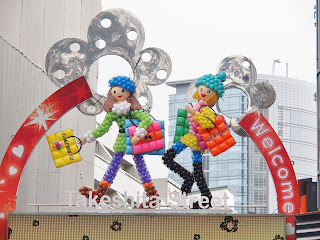The grey
clouds drift back and forth with the threat of more snow. People bustle about
through the ancient gingko trees adorned with the lingering snow.
Tiny buds struggle free from the constant chill in search of warmth that the changing seasons bring. The distant pulsing of drums draws attention to the gates of the Meiji Jingu Park as crowds wait in anticipation of the biggest drum we have ever seen.
The scene is one of laughter and celebration for the National Foundation Day Festival on February 11 marking the accession of Jimmu the first Emperor of Japan to the throne in 660BC.
Japans Festivals or Matsuri, number in the hundreds each year but originally one of the four largest Festivals, National Foundation Day was abandoned after World War II but re-established in 1966.
But there are more exhilarating things to behold as we walk further into the Japanese crafted tree lined gardens. The main gates to the park open with a walkway of melting snow and rows of Sake Barrels. To one side three rows of barrels made of the Yoshino Sugi wood – give off a hint of cedar while larger barrels a little further on are wrapped in rope tied rice paper featuring various Japanese language symbols. As locals bustle by chatting rapidly and laughing like giddy school girls, it is a delight to be swept up in the atmosphere of their National Day holiday.
One of the most spontaneous events that one can witness in Japan is a procession of Shinto Priests but it is very much right time right place. Today the gods smiled on us as approaching on our left in a perfectly spaced procession are the very priests that we have longed to encounter.
My heart races as the Shinto priests approach my position in the garden. Dressed in the joe- pure cloth- made of cream linen, a peaked cap – tate eboshi- and ballooning trousers, they glide in uniformity like birds sweeping along behind their leader. Their feet are wrapped in traditional two toed white socks that have been wedged into sandals. Made of a flat piece of wood on two slats, they are designed to keep the Yukata or Kimono from touching the ground. A black cover is added during the wet seasons.
An armed guard prevents onlookers from getting too close as the sweep by. Some managed a quick smile for the onlookers while the younger ones seemed more focused on getting the steps right.
This is in stark contrast to what lies outside the walls of the park. Modern Japan looms all around with shopping malls decorated with pop dolls and brightly coloured neon
signs. It is such a mix of old and new, tradition and progress. Out in the narrow streets more drums sound out the call of celebration. A parade of artisans begins the slow march to the gates of the park in readiness for the evenings festivities.
The Omikoshi carriers are a blend of traditional colours with others respendant in bright and colourful dress.
Entering
the Temple surrounds we are thrilled to find a wedding about to take place. It
is said that Japanese marry in the Shinto faith and are cremated in the
Buddhist faith. The Shinto religion considered to be the oldest in Japan is as
revered today as it was at its inception in 660 BC. There is no leader, no
book, and no direct concept of religion- just a belief in harmony with nature and
“Magokoro” a sincere heart. As the wedding procession is shielded by umbrellas
to protect the bride from the drizzling rain, we move to a better vantage
point. Suddenly the procession of priests enters from a shielded building to
preside over the ceremony so we feel they are not the only ones to be blessed.
A comedy
involving a Japanese couple and a camera begins to unfold around us as we become bemused by their gestures and antics. My brother it seems
has been mistaken for Sean Connery. With much bowing and smiling, he is the
most photographed person in the park at that moment. Were they not aware of the
wedding that was taking place?
As local
school bands each uniquely clothed in group colours begin to enter the park, we
press ourselves against the roads edge believing the procession to be at an
end. The children seem to delight in the celebrations even with the temperature
sitting at just 4 degrees. The drums- they are still pounding- follow the
drums. For all of our excitement the Festival has not yet begun.
Back at
the entrance to the park, Omikoshi – portable shines- are still gathering. Women and men alike are
taking turns to carry the heavy wooden structures to the bridge and over into
the archway of the Meiji Jingu Park. It is hard to say just what was the highlight of the visit -the drum to beat all
drums - the parade of the Shinto priests - or witnessing a traditional Japanese wedding. When all is laid out it is evident that all of the events have created incredible memories of a day out of the city.










No comments:
Post a Comment